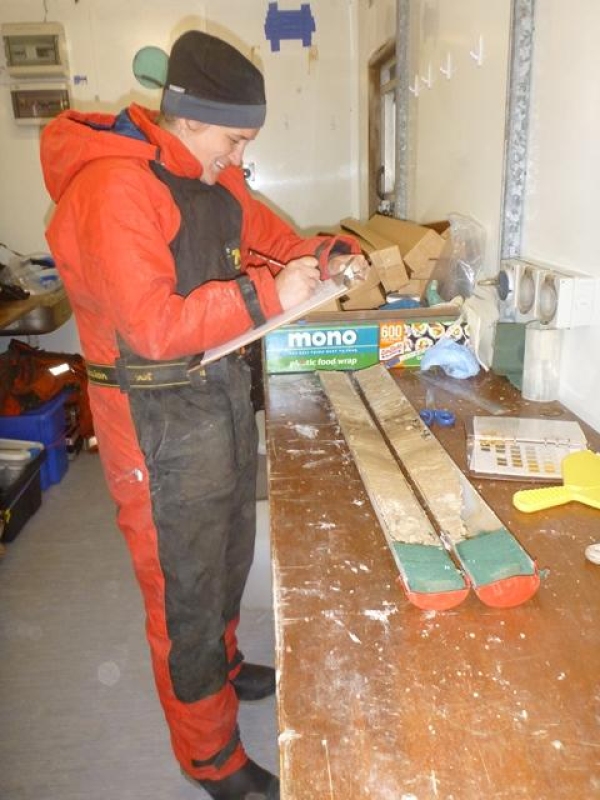The Southern Ocean has a strong influence on New Zealand and global climate. To understand how the oceans have changed over 1000s of years we use sediment archives from the seafloor.
Overview
The Southern Ocean connects the Atlantic, Indian and Pacific Ocean basins and consequently plays an essential role in the redistribution of heat, salt, nutrients, gases (including CO2) and other properties throughout the global ocean. In addition, intermediate and deep water masses are formed by physical processes in the Southern Ocean. New Zealand sits at the cross roads between the warm, subtropical waters from the north and the cold, subantarctic waters from the south. These waters meet and mix at the subtropical front, the northern boundary of the Southern Ocean. The Southern Ocean plays an important role in glacial/interglacial climate change, cycles which occur every 100,000 years.
It is important to understand past natural variations in global climate, in order to determine the effects of anthropogenic climate change. We can provide a longer term view of multi-decadal cycles than the historical records, which are relatively short for the Southern Ocean. We also look at evidence from previous warmer interglacial periods as analogues for what might happen to the environment with the current warming trend.
Approach
We retrieve sediment cores from the sea floor using a gravity (or piston) coring set up (basically a long metal cylinder with a heavy weight on the end which is lowered to the ocean floor and then pushes under its own weight into the sediment). These sediment cores are archives of past changes in the ocean as microscopic organisms, dust and ice rafted debris that is deposited by ice bergs, fall through the water and accumulate on the sea floor.
We cannot directly measure the past ocean temperature, nutrients, productivity, current speeds, sea-ice extent or oceanographic fronts. However, back in the laboratory we can analyse the cores for changes in the sediment properties including: grain size; the proportion of different types of sediment; the types of microfossils; and the geochemistry of the fossils. From analyses of surface sediments we know how these data relate to the modern environment. Therefore we can use the data as proxies for past changes in the oceans over 1000s of years.
Outcome
Proxy data from the cores indicates that there were large changes in the ocean fronts and currents during the last glacial, approximately 20,000 years ago. At this time sea level was 120 m lower than today due to the increased ice volume in Antarctica and the Northern Hemisphere ice sheets. The sea surface temperatures around New Zealand were 3-5°C cooler than modern temperatures and the Subtropical Front shifted north by 3° latitude on the west coast. To the east the front remained over Chatham Rise, controlled by the topography. Further south the winter sea ice extent was as far north as 55°S and there were large numbers of ice bergs over the Campbell Plateau, some reaching as far as Chatham Rise.
Around 18,000 years ago there was a rapid retreat of the sea ice and warming of the Southern Ocean. The fronts, where they are not controlled by the topography, shifted back to the south. This warming was briefly interrupted by the Antarctic Cold Reversal , which was a period of cooling around 14,000 to 12,500 years ago. The warmest conditions were achieved around 10,000 to 6000 years ago, when the Subtropical Front was at its furthest south. Around 7,000 years ago modern sea level was reached and modern ocean circulation achieved.
Reference: Bostock et al., 2012 Review of the Australian/New Zealand sector of the Southern Ocean over the last 30 ka (Aus-INTIMATE project). Quaternary Science Reviews. XX 1-23m. DOI: 10.1016/j.quascirev.2012.07.018
Future work
There are still significant gaps in our knowledge of the Southern Ocean, and together with colleagues in Australia and around the world we are continuing to study sediment cores collected in this region by RV Tangaroa and other research vessels. We are developing new geochemical proxies to learn about the changes in the acidity, nutrients and productivity of this region. We work closely with our physical and chemical oceanography colleagues to compare past changes with the modern variability they are observing.
Mertz Polynya voyage blog
During Feb/March 2013, the RV Tangaroa and a team of NZ and international scientists are voyaging to Antarctica's Mertz Polynya. NIWA scientist Dr Helen Bostock, assisted by some of her colleagues, is blogging throughout the voyage about their science, and life on board.
Mertz Polynya voyage blog (Sciblogs)




